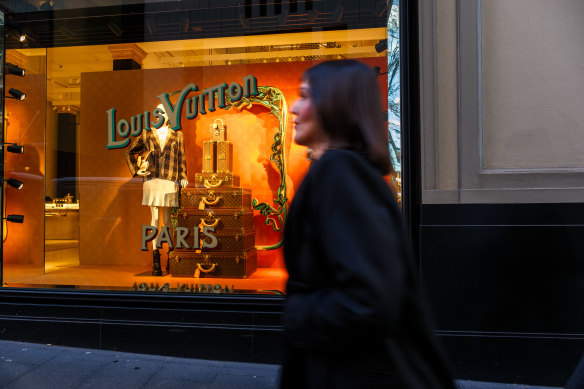
While his brands will be front and centre, Arnault’s low-key public profile is a sharp contrast to those of Musk and Bezos. Although his company is adept at digital marketing, he’s not on social media himself. He can almost blend into the crowd, sitting quietly in his sombre suits in the front row at fashion shows. Unsurprisingly, though, he’s well connected: he received the Légion d’honneur in March from President Emmanuel Macron, whose wife, Brigitte, taught French to two of Arnault’s sons.
“He is almost like a head of state; he has that level of influence,” says political image consultant Frank Tapiro, dubbing Arnault the “godfather of the Olympics”. Tapiro, who worked with Arnault as creative director for the launch of the Miss Dior perfume, likened him to Louis XIV, the 18th century Sun King famed for wielding incredible power over his capital from afar.
An engineer who started out at his family’s construction firm, Arnault launched his career in luxury by taking over Financière Agache in 1984. He dumped his acquisition’s less attractive businesses, keeping only the crown jewels: Christian Dior and ritzy department store Le Bon Marché. Within five years, he had taken a stake in LVMH and become chief executive of the company, born from the merger of Moët Hennessy and Louis Vuitton — brands established centuries before.
Arnault made his fortune by defying conventional wisdom, building a conglomerate in a field where rarity and exclusivity are watchwords. The company’s sheer size has created what Solca calls the “mega-brand virtuous cycle”: its size and large profits let LVMH recruit top design talent, open bigger and flashier stores in elite locations, and support its brands with marketing and advertising spending that each brand could never attain on its own. That boosts profits further, and the cycle repeats.
LVMH today is three times the size it was in 2009. Last year, it reported €86.2 billion ($141.4 billion) in revenue and €22.8 billion in profit from recurring operations, for a more than 26.5 per cent profit margin – one that businesses in sectors such as cars, airlines or food retail can only dream of. It’s a public company, but family-run. Arnault’s five children each play roles, leading to media speculation about who will succeed him at the top. However, his move to extend the retirement age for his job from 75 to 80 indicates he could be around for a while yet.
Arnault’s forte is balancing heritage with innovation to keep venerable brands from stagnating and giving top designers the freedom to update the classics. Louis Vuitton boosted its aura of exclusivity by multiplying handbag styles through limited editions, with partners such as artist Jeff Koons, allowing buyers to feel they have something different from the pack – an approach Solca termed a “multi-pronged innovation engine” that keeps quantities limited and prices high.
“Mastering the paradox of star brands is very difficult and rare,” Arnault once told the Harvard Business Review, adding, “fortunately.”
“Our whole business is based on giving our artists and designers complete freedom to invent without limits,” he said. “If you look over a creative person’s shoulder, he will stop doing great work.”
In the topsy-turvy world of luxury sales, raising prices can actually increase demand – to say nothing of profits – by underlining the desirability of, say, a Louis Vuitton handbag that can cost $US3000 or more. The growing number of extremely wealth people who can afford luxury goods, and the company’s early move into China as it developed into a major luxury market, have buoyed his fortune, too.
Given the company’s emphasis on its French heritage, the Paris sponsorship is “quite congruent with LVMH’s image”, says Qing Wang, professor of marketing and innovation at the University of Warwick’s business school in Britain. “With the Olympics in Paris, it’s an opportunity to highlight that connection.”

LVMH is the owner of some of the world’s most recognisable brands.Credit: Oscar Colman
The modern Olympics were invented, after all, by a French nobleman, Baron Pierre de Coubertin, and French remains one of the Games’ official languages.
“We do feel a responsibility because our brands are very notoriously French. We are French,” Antoine Arnault told the AP. “My father is very deeply French and loves his country. So, we feel a responsibility to, yes, to do things the right way.”
The company’s €150 million financial contribution, a figure reported by news media and analysts but not confirmed by the organising committee or the company, would place LVMH at or near the top of the Games’ largest sponsors list. The sponsorship helps the organising committee reach its stated goal of a privately funded Games that avoid the cost overruns of earlier Olympics. (The Games’ €4.38 billion budget is 96 per cent covered by private revenues, including from sponsors, ticket sales and television revenue. The 4 per cent share that is public funding goes toward the Paralympic Games that follow.)
Loading
There are risks to LVMH’s image investment – if, for instance, the Games are marred by protests in France’s unsettled political climate. “The French are considered world leaders in protesting,” notes Solca. And it’s an undeniable fact that, as Solca puts it, “luxury thrives on income inequality” – while Macron has touted the Games as wide open, critics have seized on the unattainability of access to many events and the luxury brands intertwined.
One thing is fairly certain: Paris won’t see a sudden surge in luxury shopping during the Olympics.
The crowds may discourage rich travellers from coming to spend, and street closures will hinder access to stores – including Avenue Montaigne, where LVMH’s flagship store stands.
AP









 Add Category
Add Category